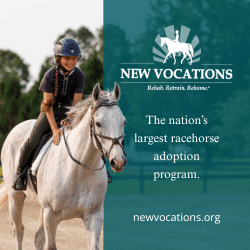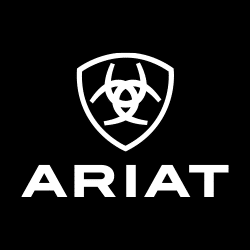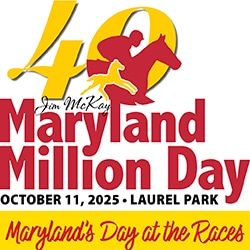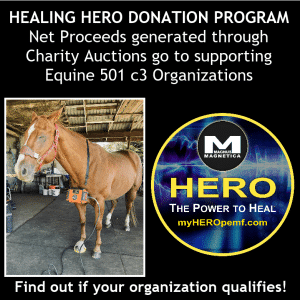On the road or in the skies, privately or commercially, many racehorses are frequent travelers

Courtesy Brook Ledge
At any major equine event you’ll see all types of horse trailers. Large outfits bring gigantic multihorse rigs, complete with human sleeping quarters, while the owner of one horse might pull in with a simple two-horse step-up.
Any safe hauling method works well if the horse fits comfortably in the trailer and has schooled for it. Problems arise when a horse hasn’t received proper loading lessons for the type of trailer he is asked to board.
Off-track Thoroughbreds usually come with full sets of loading instructions. Though it can depend on where they ran, racehorses are typically quite familiar with walking onto multihorse vans and shipping long distances.
Sharla Sanders serves as operations manager for Doug O’Neill, who trains a large racehorse stable headquartered in Southern California. O’Neill’s horses compete at the top levels, and he frequently ships them across the country and even internationally for races. O’Neill runners made 1,194 trips by van or airplane in 2018 alone. O’Neill has won the Kentucky Derby twice, with I’ll Have Another in 2012 and Nyquist in 2016.
I’ll Have Another demonstrated how often a racehorse can board a van or a plane. Foaled in Kentucky, he sold at auction there and in Florida before beginning his racing career in California. He raced at all three major tracks in Southern California and competed in Kentucky, Maryland and New York. I’ll Have Another then shipped to Japan to stand at stud for several seasons before returning to California in 2018 to continue his stallion career there.
By Land or By Air
Racehorses on major circuits often travel by plane, depending on the circumstances. “Plane vs. van would be because of the distance or it can be a financial component,” says Sanders. “Not every owner can afford to have their horse fly, but our preference for a long distance is flying.”
Flying, which also requires van rides to and from the airports, takes less time and, therefore, is less stressful for the horse. Trainers might ship a horse in early if they feel he needs time to get acclimated or would do better with a few training days over that track. Or, horses can arrive closer to race day, depending on a track’s requirements as to when horses must be on the grounds.
Sanders says O’Neill sometimes ships horses that are easily stressed by transport to a track early — how early depends on the individual horse. Horses that get anxious and need medications, such as a mild sedative, to ship safely arrive early because, by regulation, those medications must be out of the horses’ systems before they can race.
Sometimes trainers send their grooms on flights with the horses, which is helpful because the horses know their handlers and vice versa. However, some major companies that fly horses, especially internationally, staff flights with their own grooms and vets.
“It’s cost-effective for us to be able to send an employee on the plane (instead of the groom flying separately on a regular commercial flight),” says Sanders. “Also, the groom gets there the same time as the horse. We can put our people on vans, as well, which is nice because (on a long trip) they will stop after a certain amount of hours,” and the grooms will be there to tend to them.
While commercial haulers have people to care for the horses at rest stops, Sanders says trainers often feel more comfortable having their regular staff provide that care.
Personal or Commercial
In states such as California, Florida, Kentucky and New York, which have multiple tracks, horses ship frequently between ovals by vans. For example, O’Neill keeps horses at Santa Anita and Los Alamitos most of the year, two Southern California tracks about 35 miles apart. Horses training at Los Alamitos during the Santa Anita race meet might have to ship across town for a race, or O’Neill might move horses back and forth depending on how close to a race they are.
Small-scale trainers might haul horses using their own rigs. However, for large operations such as O’Neill’s, it’s easier and more labor- and cost-effective to hire a commercial hauler. These haulers ship regularly between tracks, and Sanders says finding a convenient schedule to accommodate a horse’s racing requirements is easy.
“For us it’s all commercial,” she says. “As soon as Doug starts to come up with a game plan about who he wants to ship where, the first thing I’ll do is check when is the next flight and work back from there (to coordinate vanning).”
Most large commercial hauling vans hold up to 12 or 15 horses. The number depends on the space an owner reserves. Most horses travel in what’s termed “a stall and a half,” about 4 by 9 feet, though they can also ship in a box stall that’s about 8 by 9 feet.
“With a box stall, a horse has the ability to lie down if it wants to,” says Sanders. “Box stalls are more expensive. We’ve done it for particular horses, predicated on whether the owner prefers that. But the vans are so safe — they have all kinds of cameras and other things to ensure the horses’ safety.”
Most commercial vans have long ramps and wide doorways, making it easy to load even difficult horses. In fact, your off-track Thoroughbred could conceivably have never experienced a two-horse trailer or a step-up ramp during his racing career.
“Maybe the only time they were on a step-up trailer is when they were a baby going to get broke,” says Sanders.

Courtesy Brook Ledge
Paperwork and Documentation
Once Sanders knows a horse will be shipping, she checks to make sure she has a current negative Coggins test for him (required by each track for entry) and a health certificate, which indicates a horse is healthy enough to travel. If not, she arranges to get one through the stable’s veterinarian.
“Some states require some additional things,” says Sanders. “We work closely with the vet to be sure the health certificate has what is needed.”
Because of the large numbers of horses at racetracks and the frequency with which they come and go, the backstretch of every racetrack has stringent biosecurity requirements. Most commercial haulers maintain those same biosecurity measures.
Sanders also arranges for the horse’s registration papers to be moved to the next track; the papers must be on file at the track before he can race there. This will become more streamlined as The Jockey Club, which registers Thoroughbreds, moves to digital papers, beginning with the 2018 foal crop.
International travel also requires certain documentation and various quarantine protocols, and Sanders makes sure these processes go smoothly, as well.
“If the horse is traveling internationally, I have to create the paperwork so that the horse has an actual passport, just like a human being,” says Sanders.
On longer trips the O’Neill stable sends food and sometimes water with the horses. Commercial haulers provide that, but trainers often want their charges to have consistency in their feed.
The stable also outfits the horses with safety measures as a top priority.
“We put four (standing) bandages on, bell boots and sheepskin around the halter for cushion,” says Leandro Mora, O’Neill’s primary assistant trainer. He adds an Elastoplast bandage around the bottom of the horses’ feet if the trip will last longer than three hours. He has found that as horses tire of traveling, their chances of sliding around and injuring themselves increase; the bandage helps prevent that.
When making travel arrangements, the racehorse trainer’s goal is the same as it is for the rest of us — getting the animals to their destination safely and ready to perform at their best.










